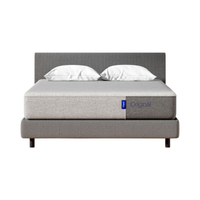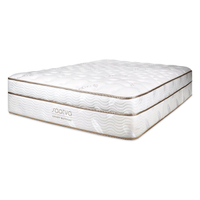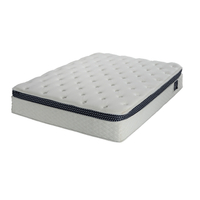The best mattress for back pain could be one made with multiple layers of foam, or it could be a hybrid – a mattress designed with a mix of foam plus coils or springs. Many chiropractors preach about the benefits of memory foam for relieving back pain, and we’ll explore the Top 5 in this article. We’ll also flag up the best memory foam mattresses for back pain relief and support, and at different budgets too so you have plenty of choice.
5 reasons why memory foam mattresses are good for back pain
1. Memory foam relieves pressure on your body
Waking up with back pain can put you on the back foot for the rest of the day, so a bed that supports your spine and relieves pressure is a must. A number of our overall best mattress picks are made from memory foam, because good memory foam offers the ideal mix of support and comfort, while keeping your spine in neutral alignment so it doesn’t bend or twist out of shape. Memory foam reduces pressure spots across your body by distributing your weight evenly along the mattress. This ability to redistribute weight is called pressure relief and memory foam mattresses are excellent at it. When you mix pressure relief with contouring and spinal support, as you’d get in memory foam, the result is a comfortable mattress that molds itself around your shoulders, back and hips to prevent pain points. The right level of pressure relief for you depends on your body type and sleeping position. If you’re a side sleeper weighing under 130lbs, your best mattress for side sleeping is made of soft foam. To relieve pressure in the lower back during back sleeping, choose a medium-firm feel. If you weigh over 230lbs and sleep on your stomach, try a firm memory foam bed.
2. They work with zero gravity beds
Placing your body in a zero gravity position creates a sense of weightlessness when you lie down. You can do this to an extent by arranging a series of pillows beneath your head and upper back and underneath your knees and lower legs. However the best way to experience it is with an adjustable bed. Many of these have zero gravity presets, so all you have to do is push a button and the bed adjusts itself in this position. A lot of memory foam mattresses are compatible with adjustable beds, so you can enjoy pressure relief and weightlessness to reduce back pain when lying down and sleeping. According to back specialists at Mather Hospital (opens in new tab), sleeping in a zero-gravity position puts your spine in a neutral position, ‘simulates weightlessness and puts less pressure on your body.’ In short, your back is relieved of all tension and pressure.
3. Memory foam isolates motion from your partner
After finally falling asleep with back pain, there’s nothing worse than being woken up by a fidgety partner. When awake you may become instantly aware of the pain again, and you’ll have to restart your process of getting comfy and relaxed. Memory foam is an excellent material for absorbing and isolating motion from your partner. Some foams are better at this than others, but generally memory foam mattresses reduce motion transfer much better than hybrid, latex and innersprings. If you don’t feel your partner’s tossing and turning, you’ll have less chance of being woken up when you finally get comfy enough to drop off.
4. Memory foam comes in a range of firmness levels
Like latex (a popular organic mattress), memory foam can be used to create different levels of firmness in a mattress. This ranges from soft to firm, depending on the type of foam used, how many layers are packed into the mattress, how deep those layers are and if any other materials are used (such as springs). Most health experts agree that a medium-firm mattress is the optimal choice for back pain relief and support for most body types and sleeping positions. Medium-firm hits that sweet spot between comfort and support, but it might be too soft if you weigh over 230lbs or too firm if you weigh under 130lbs. All of the best mattresses in a box come on a 100-night trial or longer, so you’ll have the time you need to make sure you’ve picked the right memory foam firmness for your back pain.
5. It’s comfy for back pain-friendly side sleeping
According to the Mayo Clinic (opens in new tab), the most effective sleeping position for back pain relief is to sleep on your side with a pillow wedged between your knees. This helps take the strain off your back. Draw your legs up slightly toward your chest but don’t curl them (foetal position) as this can worsen your back pain. Memory foam is one of the most contouring materials for side sleepers as it cushions your hips, shoulders and knees as you sleep on your side. This is necessary if you sleep on one side for hours at a time without switching. If you have a much lighter than average body, look for a pillow top memory foam mattress or consider investing in one of the best mattress toppers for adding foam-soft comfort to your bed.
Which foam mattress is best for back pain?
There are some great all-foam beds for relieving back pain and boosting lumbar support, but there isn’t one to rule them all. Mattress firmness and comfort is subjective, so what eases your back pain could make the next person’s pain worse. Here are three memory foam beds recommended for back pain…
Are foam mattresses good for back pain: Summary
On the whole, memory foam is an excellent choice for people with back pain because it heats up to your body temperature in order to contour to your curves. But that also means they aren’t a comfortable choice for hot sleepers who would be better suited to one of the best cooling mattresses for reducing overheating. Our top tip would be to ask your chiropractor, doctor or physical therapist what mattress firmness would reduce or relieve your back pain to help you sleep comfortably for longer. There are plenty of all-foam beds available on a trial basis, so you’ll be able to test drive one before fully committing.


